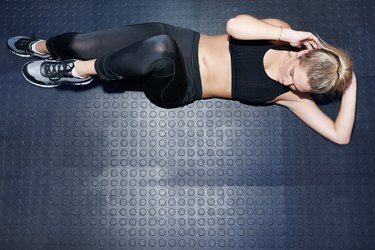
"Cramp" is a word often used to describe any kind of pain in a muscle. If you're experiencing a cramping sensation in your stomach when doing sit-ups, it first might be helpful to determine if you're actually getting cramps.
Stomach Cramps After Sit-Ups
Video of the Day
An ordinary muscle cramp is a sudden, involuntary contraction or over-shortening of the muscle. It can last for several seconds or minutes and can cause mild to extreme pain as the muscle impinges on the nerves. You may feel a few brief spasms or twitches before the onset of the full cramp. With severe cramps, the muscle may stay sore or tender for a few days.
Video of the Day
One form of stomach cramps is common enough to have been awarded a medical phrase: Exercise-related transient abdominal pain, or ETAP. It's commonly referred to as a "stitch." It's most likely to occur in activities with repetitive torso movement, with the torso in an extended position.
ETAP is a localized pain that's usually felt to the sides of the mid abdomen, though it can occur anywhere in the abdomen. It can also be referred from nerves in the shoulder. When acute, ETAP can be sharp or stabbing. When less severe, it may take the form of cramping, aching or pulling. ETAPs can have a number of different causes and should be easy to avoid when you isolate the reason for them.
Don’t Eat or Drink
Eating and drinking fluids before exercise is a likely cause of stomach cramps. In addition, the more you eat or drink, the more like you are to experience abdominal pain during exercise. Clear fluids have been shown to be less irritating than thicker solutions like juices. If dehydration during workouts is a problem, try gradually increasing the amount of fluid you drink. The gut seems to increase its tolerance to larger quantities of fluid over time.
Be Sure to Warm Up
Warming up with stretches may your best bet for avoiding abdominal cramps during exercise. Gentle stretching — in this case of the abdominal muscles — is both prevention and cure for the cramps. A general warm-up with some cardio is always recommended, and sun salutations are a gentle way to warm up the whole body.
You might perform three rounds of vacuum, which is drawing your stomach inward toward your spine and holding it for 30 seconds. Stretching, or other gentle exercise prior to going into high gear with sit-ups or other abdominal exercises, reduces the chance of muscle fatigue, which can lead to ab cramps after a workout.
Drink Your Water
Although dehydration and its accompanying depletion of electrolytes are commonly cited as a reason for muscle cramping, there's not actually a lot of research to support this. And unless you've done 800 sit-ups in a steam room or have been working out strenuously for hours, you're unlikely to get dehydrated just by doing sit-ups. Still, it's worth taking into account.
According to ACSM's Health & Fitness Journal, dehydration is defined as exercise weight loss greater than 2% of body weight. Needless to say, it's also important to eat a balanced diet because most fluids and electrolytes are replaced at meals.
The American Council on Exercise recommends drinking 17 to 20 ounces of water two to three hours before starting exercise and another 8 ounces 20 to 30 minutes before you start your workout. You should also consume 7 to 10 ounces every half hour during exercise and 16 to 24 ounces after exercise for every pound of body weight lost to sweat.
Read more: How to Loosen Contracted Muscles